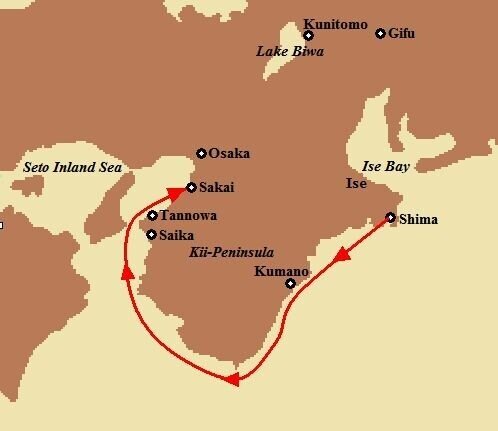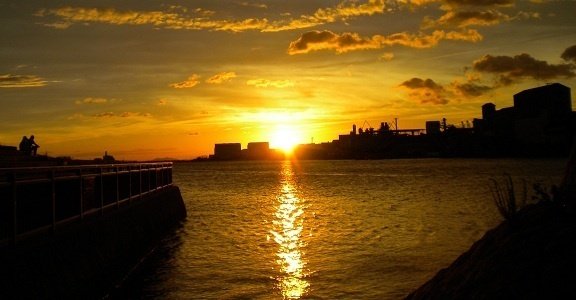
The Arrival of Kuki's Fleet at Sakai —Sakai, 20 August 1578

Oil on canvas, 65×80cm, 2015-2021, M.Tsushima
Seapower was what samurai warlords coveted. Ruling Japanese archipelago required having a strong navy, especially in the Seto Inland Sea, where the tension was intensified between powerful warlords and Buddhist powers.
Nobunaga was pioneering naval force in order to defeat his archrival, Honganji Temple.
Background
Nobunaga's territory expanded westward in the early 1570s to the extent that it reached Osaka, where the formidable Buddhist power, Honganji Temple, headquartered. As the tension between Nobunaga and Honganji escalated, in the spring of 1576, Honganji troops of fifteen thousand believers suddenly attacked Nobunaga's army. Nobunaga counterattacked and began the siege of the Honganji Temple which was fortified with moats and earthworks.
On 9 August 1576, the siege was broken by the fleet of Honganji's ally western warlord, Mori Terumoto: Mori's six hundred boats shot fire arrows to burn Nobunaga's boats that had blocked the estuary of Kizu-gawa River leading to Osaka.
Nobunaga ordered Kuki Yoshitaka to organize a strong navy to block Osaka bay to repulse Mori's fleet. Kuki's fleet set sail on 30 July 1578 at its home Shima Province, went around Kii Peninsula, and arrived on 20 August 1578 at Sakai, 15 kilo-meters south of Osaka.

Accounts
A buddhist monk of Kofukuji Temple, Tamonin Eishun (1518-1596), writes in his diary[1]:
The other day, big ships from Ise arrived at Sakai bay: about 5,000 people aboard; the width of seven-ken, the length of twelve to thirteen-ken. They are iron ships: well protected against firearms. It is said that they press on to Osaka in order to block the route.
A Jesuit missionary, Gnecchi-Soldo Organtino (1530-1609), writes in his report[2]:
...what happened after that was that yesterday, on the important Japanese holiday, Nobunaga's seven ships arrived at Sakai. Built in Ise Province by the order of Nobunaga, they are the largest and most elegant in Japan: they resemble ships of the Kingdom. I went to see them and was surprised by that those were made in Japan. Nobunaga ordered to build the ships in order to put them at the estuary of Osaka where he was in the war for four years, to prevent vessels loaded with reinforcement soldiers or provisions from entering into the port. This will ruin the city of Osaka. The ship carries three cannons. I do not know where do they come from, because, as far as we know, there are no cannons in Japan except a few small cannons ordered by the king of Bungo. I went to see the cannons and their devices. They are furthermore armed with innumerable elaborate and large long guns.
Ota Gyuichi(1527-1613), a samurai who served Nobunaga, writes[3]:
Kuki Umanojo of Ise Province was ordered to build six large ships, as well as Takigawa Sakon was to build one large ship, which was built as a white ship. Waiting for a fair wind, they set sail to Kumano Bay on June 26th. While the ships navigating toward Osaka, on the offshore of Tannowa, innumerable small boats from Saika, Tannowa, and many bays, in order to stop the large ships, rushing, shooting arrows and muskets, attacked the ships from all sides. Kuki Umanojo, decorating the seven large ships like mountains, accompanied by small vessels, having the enemy boats to come closer, handled them as if welcoming them, then fired a salvo with the cannons and destroyed a lot of enemy boats. Thereafter, the enemies had no way to come close. On July 17th, without any trouble, the ships arrived at the port of Sakai. Crowds were astonished. Following day, the fleet pressed on to Osaka, where the ships were located close to the other, blocked the waterway, strengthened the siege.
Venue
Sakai was one of the most important port towns in Japan in the 16th century. Francis Xavier(1506-1552) who visited Sakai in 1550 writes: The port of Sakai is the busiest and most lively city in Japan. It is the place where most of gold and silver in Japan are collected.
A Jesuit missionary, Gaspar Vilela(1526-1572), writes in his report to Portugal in 1561: The city of Sakai is very large and there are a lot of powerful merchants. The city is governed by the consuls like Venice.

The city of Sakai was exceptionally governed by municipality and independent of warlords. It flourished by trade, especially of muskets and gunpowder in the 16th century. That attracted Nobunaga who, in 1568, required to Sakai for donation for military support. Sakai, though once resisted, agreed to it and thereafter was under Nobunaga's rule.
When the war on Honganji began, Sakai was an important outpost to Osaka. In 1574 Nobunaga invited ten powerful Sakai merchants to a tea party he held in Kyoto to establish communication to Sakai. Furthermore, in 1575 Nobunaga appointed his vassal, Matsui Yukan, as the first Sakai Governor and ordered him to collect money, procure ships, and gather information on Honganji and enemy warlords, though warships prepared in Sakai alone were not enough to reinforce the siege of Osaka.

The Fleet
The fleet arrived at Sakai was led by Kuki Yoshitaka(1542-1600), who was ordered by Nobunaga to build strong warships.
Kuki was, among the warlords under Nobunaga, the most skilled in naval battle. He ruled Ise Province, the east side of the Kii Peninsula, where Honganji troops rose up against Nobunaga in 1574, Kuki provided naval fire support to Nogunaga's army to annihilate Honganji troops.
After securing the control of Ise, Kuki's next war theater was on the opposite side of the Kii Penninsula, Seto Inland Sea, where the powerful warlord, Mori Terumoto, established control leading his strong navy which was composed of experienced samurai warlords ruling the difficult waterway meandering between hundreds of islands.
It was 1576 when Nobunaga's fleet blocking the Osaka Bay was defeated by Mori's navy which made a grenade attack on Nobunaga's vessels to burn them all down, allowing them to supply food and ammunition to Honganji.
In order to block the Mori's navy, Nobunaga began development of warships capable of defending against enemy fire.
Now in 1578, the ships showed up. It had innovation both in offence and defence.
As for offence, the ships were armed with cannons and guns. In Japanese warfare, firearms were introduced after 1543 when a Portuguese ship arrived at Tanegashima Island where the local samurais bought two muskets from the crew members and developed gunpowder and firearm technology, Later a mercient from Sakai,Tachibanaya Matasaburo, came to Tanegashima Island and learned the firearm technology for a couple of years. Back in Sakai, he began mass production of guns. Already in 1570, the battle of Honganji in Osaka saw 3,000 muskets, but in the sea fight, firearms still saw little use. As for large guns, there were no cannons in Japan except a couple of Frankish cannons imported by Jesuit missionaries to the warlord in Kyusyu Island, Otomo Sorin. Meanwhile, Kuki's six warships built in 1578 were each mounted with three cannons and many long guns: that was an amazement for the Jesuit missionary, Gnecchi-Soldo Organtino, who witnessed the warships and reported their detail to India and Europe, but Nobunaga could procure so many guns since he took control of the two majour gun production centers, Sakai and Kunitomo.
As for defence, there are two factors: size and protection.
The size of the ships, according to the diary of Tamonin Eishun(1518-1596), a Buddhist monk of Kofukuji Temple, was the width of seven-ken(13 m) and the length of twelve to thirteen-ken(22-24 m). But this dimension has the length too short to the width. Another account, which is one of the copies of Ota Gyuichi's document, Shincho Koki, gives it more physical reality: the length of eighteen-ken(32 m) and the width of six-ken(11 m)[4].
This is not the first time, however, that Nobunaga built a large ship. Five years earlier, in 1573, Nobunaga built a ship to fight on Lake Biwa. It was thirty-ken(55 m) long and seven-ken(13 m) width, larger than Kuki's ship in 1578. The ship, though it once was used in a war to conquer a lakeside town of an enemy warlord, was not fast enough for transport purpose: after three years of service, in 1576, the ship was dismantled to build ten smaller, faster ships. The smaller size of Kuki's ship, therefore, might more focus on balance between strength and speed.
The gist of defence, however, is the height of the hull, Though not written in the accounts, it must have been higher than that of the ships that were defeated in the 1576 sea fight, in which Mori's boats fired a weapon called a horoku-hiya. So, what is horoku-hiya? Ota's document implies that the weapon had not been known to Nobunaga's side. We now see it in the ninja textbook, Bansen Shukai, written in 1676[5]; horoku-hiya is a terracotta ball containing gunpowder with a fuse attached. The gunpowser was a mixture of five ingredients, burning deadly fire, but it was heavy, weighted 1.5 kg. Including the terracotta ball, a horoku-hiya weighs about 2 kg. It is uncertain how they shot the heavy ball, but it must have been hard to throw it into a ship with a tall hull.
The second factor of the defence - protection - comes also from the diary of Tamonin; the ship was "iron ship". Since the diary of Tamonin is the only document which refers to iron, it is still questionable that the hull was really covered with iron, but as he writes that the ships were well protected against firearms, the ships must have been proof against a horoku-hiya attack: they were not to be burned in the oncoming sea fight.
The fleet was ready at Sakai to begin blockade of Osaka Bay the following day. The expectation was high. Organtino predicted in his report that this will ruin the city of Osaka, and it was to come into reality.
References
[1] 多聞院日記, 多聞院英俊
[2] 耶蘇会士日本通信 page 41/283
[3] 信長公記, 太田牛一
[4] 信長の戦国軍事学―戦術家・織田信長の実像―,藤本正行 1993
[5] 万川集海 第廿一巻 火器
